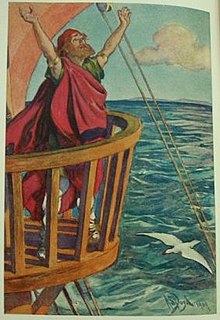

Madoc ab Owain Gwynedd (also spelled Madog) was, according to folklore, a Welsh prince who sailed to the Americas across the Atlantic Ocean in 1170, over three hundred years before Christopher Columbus's voyage in 1492. Madog's voyages are a part of the modern debate to do with the Americas' rediscovery theories. Landing in Mobile Bay, Alabama in the Southern United States, the identity of his supposed descendants have been debated for hundreds of years. The story was popularised during the British Elizabethan era from the 16th century onwards, which inspired many 19th century Welsh Americans to explore for the lost medieval Welsh tribe in America.
According to the story, Madoc was a son of Owain Gwynedd from the Kingdom of Gwynedd in modern-day Wales. He took to the sea to flee internecine violence at home due to the 12th century Anglo-Normans' invasion. The "Madoc story" legend evidently evolved out of a medieval tradition about a Welsh hero's sea voyage, to which only allusions survive, as the contemporary sources are vague about the myth of Madoc English and Welsh writers later wrote of the claim that Madoc had come to the Americas as an assertion of prior discovery, and hence an enforcement of the legal possession of British America by the Kingdom of England.
The Madoc story remained popular centuries after his voyages, and speculations predominantly from the 19th century have asserted that Madoc's fellow voyagers had intermarried with local Native Americans and that their Welsh-speaking descendants still live somewhere in the United States. These "Welsh Indians" were credited with the construction of a number of landmarks throughout the Midwestern United States, and a number of white travelers were inspired to go looking for them. The Madoc story has been the subject of much fantasy in the context of possible pre-Columbian trans-oceanic contact. No archaeological, linguistic, or other evidence of such a man or his voyages has been found in the New or Old World; however, legends connect him with certain sites, such as Devil's Backbone, located on the Ohio River at Fourteen Mile Creek near Louisville, Kentucky.